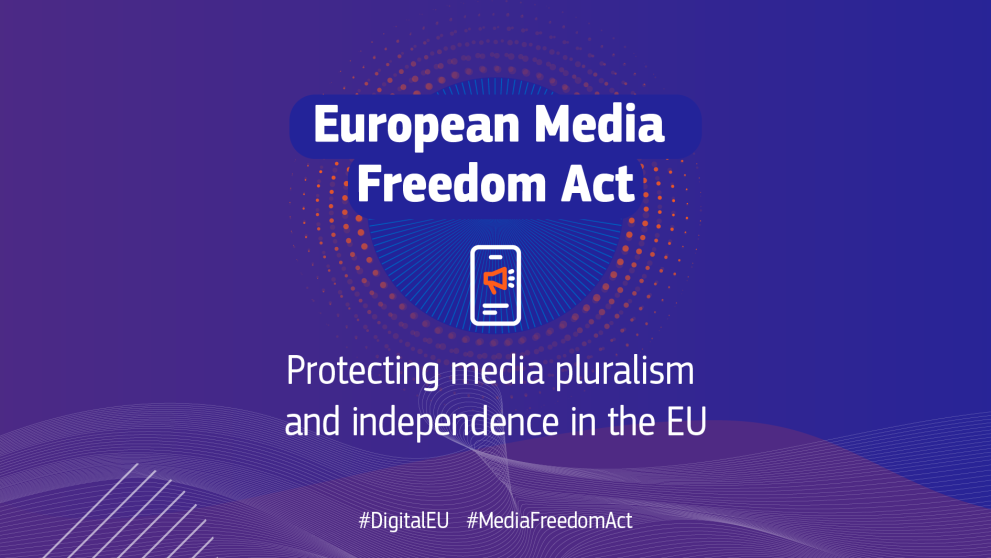April 20, 2023
The platform-media relationship in the European Media Freedom Act

The European Media Freedom Act (EMFA) proposal takes aim at very large online platforms’ (platforms) gatekeeping power over access to media content.
It focuses on two issues with platforms’ gatekeeping power in particular. One, it argues platforms limit users’ access to trustworthy content when they apply their terms and conditions to media organisations that exercise editorial responsibility and produce news in line with journalistic standards. And two, it argues that quality media may serve as an “antidote” to the disinformation and other polarising content that platforms amplify. To address these issues, the EMFA aims to reshape the relationship between media and platforms. Media organisations will be afforded special transparency and contestation rights on platforms (Article 17 EMFA), and engage in a structured dialogue with platforms on issues such as access to disinformation versus quality content (Article 18 EMFA).
By providing media organisations a special position on platforms, the EMFA risks changing the media’s role and relationships with other actors in ways that run counter to its overall objective to secure media freedom. This danger is most apparent in three dimensions, which we explore in turn: the media’s dependence on public authorities; the media’s role in addressing disinformation; and platforms’ role in fundamental rights governance, which we explore in turn. First, however, we will briefly explain how the EMFA regulates relationship between platforms and media organisations.
Regulation of the platform/media relationship in the EMFA
A key question, explored in more detail by Joan Barata, is which media organisations will qualify for the privileges afforded by the EMFA. The EMFA defines media services as those where the principal purpose of the service or a dissociable section thereof consists in providing programmes or press publications to the general public, in order to inform, entertain or educate, under the editorial responsibility of a media service provider. Article 17 EMFA furthermore only applies to media organisations that have declared to a platform that they are independent and subject to (self-)regulation. As Barata argues, the media definition under EMFA is an overly “limited” definition, which is not “aligned” with international and European human rights standards, and “discriminatory”, as it excludes “certain forms of media and journalistic activity”.
Transparency
Article 17 EMFA requires platforms to annually publish information on the grounds for and number of times they suspended or restricted access to the content of media organizations in its scope. It also requires platforms that suspend content of such media organisations to take “all possible measures” to inform the organisation of the facts and grounds that led to the suspension before it takes effect. An early draft of the EMFA leaked by Contexte also required platforms to “include meaningful information on the impact of that decision on freedom of expression, including from the perspective of media pluralism”. This language was removed from the final text.
The added value of these transparency provisions is limited compared to the rights the Digital Services Act (DSA) affords all platform users. The DSA requires an extensive statement of reasons is provided when platforms restrict access to content (including information on the facts and grounds of the decision as well as information on the use of algorithms to detect violative content). These statements must continuously be added to a database of moderation decisions operated by the Commission. The EMFA’s added value from a transparency perspective, then, is that media organizations must (if possible) be given limited information before their content is removed, and platforms’ decisions to remove or restrict access to media content must annually be aggregated in one transparency report.
Dialogue
Under article 17 EMFA platforms must also ensure complaints submitted by media organizations regarding, among others, moderation decisions and technical issues, are processed with priority and without undue delay. Media providers that believe a large platform frequently takes restriction or suspension decisions without sufficient grounds can require the platform to “engage in a meaningful and effective dialogue with the media service provider, upon its request, in good faith with a view to finding an amicable solution for terminating unjustified restrictions or suspensions and avoiding them in the future”. The media provider may notify the European Board for Media Services (the Board) of the outcome. The Board consists of the different EU media authorities and, among other things, has the task of supporting the Commission to ensure the correct and consistent application of the EMFA.
Article 18 EMFA requires the Board to organize a dialogue between platforms, media service providers, and civil society. Note that Article 18 EMFA applies to media service providers, not only those that fall under Article 17. The dialogue should cover experiences with and best practices for applying Article 17, fostering access to diverse offers of independent media, and adherence to self-regulation covering harmful content such as disinformation. The outcome of the dialogues must be reported to the Commission. Article 18, in short, goes beyond regulating platforms’ moderation of media content. It covers the availability of objectionable and diverse content on platforms more broadly, by addressing the way platforms expose users to disinformation and diverse content.
The media’s dependence on regulatory authorities
At first glance, the EMFA’s efforts to reset the platform-media relationship may seem to not amount to much. The EMFA forces platforms into various dialogues with media, but a lack of dialogue was not the issue in this relationship – the imbalance of power was. Articles 17 and 18 EMFA themselves do not impose substantive obligations on platforms that change this power dynamic. Instead, they rely on soft regulatory power by having the outcomes of formal dialogues reported to the Board (Article 17) and the Commission (Article 18). The scrutiny of these institutions, and in particular the threat of future more stringent regulation or enforcement guidelines, is what strengthens the media’s position in these dialogues.
The DSA adds weight to the threat of more stringent enforcement, as it empowers the Commission to impose substantive obligations (backed up by the threat of heavy fines) regarding the way platforms moderate content. Most notably, the systemic risk provisions require platforms to take measures (such as adapting their moderation and recommender systems) to safeguard against systemic risks, including risks to media freedom and civic discourse. Article 14 DSA, furthermore, requires platforms to have “due regard” for the ”freedom and pluralism of the media” (among other rights and interests) when enforcing their terms and conditions. As Quintais, Appelman, and Ó Fathaigh have argued, this provision can be used to require platforms to take the fundamental rights, including media freedom, into account when applying their terms of service.
The EMFA itself says very little about the ways in which the Commission and the Board should use their regulatory power in the context of the envisioned dialogues. For example, there does not seem to be an accountability mechanism for decisions by the Board about which media qualify for the Article 18 structured dialogue. There is also no explicit procedure or process set out in the EMFA for what the Board must do if a media organisation reports a conflict under Article 17. This limits accountability and oversight over the ways in which regulatory authorities intervene in the relationship between media and platforms. It also makes media’s privileges on platforms fully dependent on the way in which regulatory authorities decide to exercise their discretion. The freedom of choice this affords regulatory authorities, in particular by determining which media’s position on platforms is strengthened in practice, poses serious risks regarding their involvement in the way expression is governed on platforms.
"Structured dialogue" and the media’s role in disinformation governance
The EMFA may also affect the relationship between the media and various regulatory authorities by involving media in the governance of specific issues, most notably disinformation. Article 18 requires the Board to organise a “structured dialogue” between invited media and platforms, to “monitor adherence” to self-regulatory initiatives aimed at “protecting society from harmful content, including disinformation and foreign information manipulation and interference”. There is potential for this provision to be quite problematic, if the EMFA and regulatory authorities have grounds to view disinformation as not just a platform problem, but also a distinct media problem. This is especially the case, given that media in the EU are already being targeted under member state disinformation laws. Even the Commission’s 2022 Rule of Law report contains “serious concerns” on Greece’s criminal law on “false news”, designed to prevent the spread of disinformation and the risks it poses for journalists. It is quite significant, then, that for the first time in EU legislation, media will be explicitly associated with disinformation and foreign interference, and it is especially disappointing in a piece of legislation supposedly on “media freedom”. The media have never been part of the EU Code of Practice on Disinformation. Similarly, none of the obligations the Digital Services Act imposes on platforms explicitly mention disinformation or foreign interference. Indeed, the EMFA will be the first piece of EU legislation containing a specific provision on these two concerns.
Recital 36 EMFA explicitly envisages the Article 18 mechanism to build upon the Board’s role in “monitoring compliance” with the Code of Practice on Disinformation. As such, it needs to be carefully ensured that the Article 18 mechanism does not morph into something akin to the Code, with binding obligations and oversight for not only platforms, but also the media. As documented by both international and European human rights bodies, disinformation and fake news laws are being used to target media outlets in Europe. Three Dutch media outlets were famously forced to initiate legal proceedings to be taken off a list labelling them as “disinformation outlets”. As such, it is essential that the Article 18 dialogue, which will involve representatives of regulatory authorities from all EU member states, never veers towards viewing disinformation as a media problem, and maintains the view, recommended under human rights standards, that promoting freedom of the media is a “key means” to address disinformation.
The privatisation of fundamental rights governance
More generally, both the EMFA and DSA signal quite an astounding shift in the operationalisation and governance of fundamental rights. A key concern around (automated) content moderation are the possible implications this can have for the democratic role of the media, the functioning of the public sphere, and the fundamental rights to freedom of expression for platforms, media and citizens. Maybe what Articles 17 and 18 really are is a glimpse into a future, where monitoring potential interference with fundamental rights is no longer a matter for courts and regulatory authorities in the first place, but rather for platforms. This is a trend that has started with the systemic risk provisions in the DSA, according to which it is platforms’ task to identify and mitigate “any actual or foreseeable negative effects for the exercise of fundamental rights” (Art. 34 (1) DSA). In so doing, the DSA gives platforms considerable discretion (subject to external audits) in determining when exactly conflicts with fundamental rights are at stake, and whether to revisit the design of the service, the terms of use, advertising practices or internal monitoring procedures in response (Art. 35 DSA).
The EMFA, arguably, takes this discretion further. Safeguarding the interest of media freedom and other fundamental rights is essentially turned into a matter of VIP customer management. On the one hand, Article 17 does acknowledge the pivotal role of the media in democratic societies (on the questionable and potentially discriminatory definition of the media, see this blog by Barata). On the other hand, the proposed solution boils down to transparency, a “meaningful and effective dialogue” and “finding an amicable solution”. The rule of law and procedural rights are replaced by a “meaningful and effective dialogue”. In case an interference with fundamental rights is found, an authoritative declaration of its impermissibility is turned into “finding an amicable solution.” What is missing are any more concrete requirements regarding measures to be taken (like in Art. 35 of the DSA) and a critical discussion to what extent fundamental rights and public interests should at all be subject to negotiation. Needless to add that the amicability of any solution will very much depend on how equal the negotiation power at the table is, and how deep the structural dependencies are.
Conclusion
The EMFA’s focus on transparency and dialogue should not draw attention away from its serious implications for the media’s dependence on supervisory authorities, the media’s role in disinformation governance, and platforms’ role in fundamental rights governance. These issues are particularly important given that in the context of the other main piece of EU media law, the Audiovisual Media Service Directive, light-touch regulatory approaches have regularly been strengthened in later revisions. Under the current approach, the way the EMFA reshapes the platform-media relationship runs counter to its stated goal of securing media freedom.
This opinion article is co-authored by Max van Drunen and Ronan Fahy (both affiliated to Institute for Information, University of Amsterdam) and was originally published on the Verfassungsblog on 13 February 2023
More results /
By Roel Dobbe • November 12, 2025
By Natali Helberger • José van Dijck • Claes de Vreese • October 27, 2025
By Natali Helberger • March 06, 2025
By Kätliin Lember • November 07, 2024
By Maurits Kaptein • June 06, 2025
By Leonie Westerbeek • November 22, 2024
 What data reveals about Meta and Google’s political ad ban in the EU
What data reveals about Meta and Google’s political ad ban in the EU
By Fabio Votta • November 05, 2025
By Ernesto de León • Fabio Votta • Theo Araujo • Claes de Vreese • October 28, 2025
By Charis Papaevangelou • Fabio Votta • September 22, 2025



